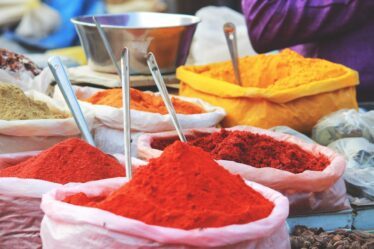
Turmeric powder is a vibrant yellow spice that has been used for centuries in various cuisines and traditional medicine practices. It is derived from the root of the Curcuma longa plant, which is native to South Asia. Turmeric powder has a rich history and is deeply ingrained in the cultures of India, Southeast Asia, and the Middle East.
In addition to its culinary uses, turmeric powder is also known for its numerous health benefits. It contains a compound called curcumin, which has powerful anti-inflammatory and antioxidant properties. These properties make turmeric powder a valuable addition to any diet, as it can help prevent chronic diseases and promote overall well-being.
Key Takeaways
- Turmeric powder is a versatile and healthy spice that can be used in a variety of dishes.
- Adding turmeric powder to your diet can provide numerous health benefits, including reducing inflammation and improving brain function.
- When choosing and storing turmeric powder, it’s important to look for high-quality, fresh powder and store it in a cool, dry place.
- Turmeric powder is a staple in traditional Indian and Southeast Asian cuisine, and can be used to add color and flavor to a variety of dishes.
- There are many recipes that incorporate turmeric powder, including curries, marinades, and beverages like golden milk and turmeric tea.
The Health Benefits of Turmeric Powder in Your Diet
One of the key health benefits of turmeric powder is its anti-inflammatory properties. Chronic inflammation is believed to be a major contributor to many diseases, including heart disease, cancer, and Alzheimer’s disease. Curcumin, the active compound in turmeric powder, has been shown to inhibit the molecules that trigger inflammation in the body.
In addition to its anti-inflammatory effects, turmeric powder also acts as a potent antioxidant. Antioxidants help protect the body from damage caused by free radicals, which are unstable molecules that can lead to chronic diseases and aging. Curcumin has been found to neutralize free radicals and stimulate the body’s own antioxidant enzymes.
Furthermore, turmeric powder has been shown to have a positive impact on brain function. It can cross the blood-brain barrier and has been found to increase levels of brain-derived neurotrophic factor (BDNF), a growth hormone that is essential for brain health. Low levels of BDNF have been linked to depression and Alzheimer’s disease, so increasing its levels through the consumption of turmeric powder may have beneficial effects on mental health.
Turmeric powder also aids in digestion by stimulating the production of bile, which helps break down fats and aids in the absorption of nutrients. It can also help alleviate symptoms of indigestion and bloating. Additionally, turmeric powder has been found to have antimicrobial properties, which can help fight off harmful bacteria and promote a healthy gut.
How to Choose and Store Turmeric Powder for Optimal Flavor
When selecting turmeric powder, it is important to choose a high-quality product to ensure optimal flavor and potency. Look for turmeric powder that is bright yellow in color, as this indicates freshness. Avoid powders that are dull or have a brownish tint, as they may be old or of lower quality.
It is also recommended to choose organic turmeric powder whenever possible, as it is free from pesticides and other harmful chemicals. Organic turmeric powder is typically more flavorful and potent than conventionally grown varieties.
To store turmeric powder, it is best to keep it in an airtight container in a cool, dark place. Exposure to light and heat can cause the spice to lose its flavor and potency over time. It is also important to keep turmeric powder away from moisture, as it can cause clumping and spoilage.
Turmeric Powder in Traditional Indian and Southeast Asian Cuisine
| Country | Usage | Health Benefits |
|---|---|---|
| India | Used in curries, rice dishes, and pickles | Anti-inflammatory, antioxidant, and may improve brain function |
| Thailand | Used in soups, curries, and stir-fries | May reduce inflammation and improve digestion |
| Indonesia | Used in curries, stews, and marinades | May improve heart health and reduce inflammation |
| Malaysia | Used in curries, soups, and rice dishes | May improve digestion and reduce inflammation |
Turmeric powder is a staple ingredient in traditional Indian and Southeast Asian cuisine. It is used in a variety of dishes, including curries, rice dishes, soups, and stews. Turmeric powder adds a vibrant yellow color to these dishes and imparts a warm, earthy flavor.
In Indian cuisine, turmeric powder is often combined with other spices such as cumin, coriander, and ginger to create complex flavors. It is used as a base for many curry powders and pastes. Turmeric powder is also commonly used in pickles and chutneys for its vibrant color and tangy flavor.
In Southeast Asian cuisine, turmeric powder is used in dishes such as Thai yellow curry and Indonesian rendang. It is also used to flavor rice dishes, such as the popular Indonesian dish nasi kuning (yellow rice). Turmeric powder is often combined with coconut milk and other spices to create rich and aromatic flavors.
Using Turmeric Powder to Add Color and Flavor to Your Dishes
Turmeric powder is a versatile spice that can be used in a variety of ways to enhance the taste and appearance of your dishes. It can be added to soups, stews, and sauces to give them a vibrant yellow color. Turmeric powder can also be used as a natural food coloring agent in baked goods, smoothies, and desserts.
In addition to its color-enhancing properties, turmeric powder adds a warm, earthy flavor to dishes. It pairs well with other spices such as cumin, coriander, and ginger. Turmeric powder can be used to season roasted vegetables, marinades for meats and tofu, and dressings for salads.
Recipes for Turmeric Powder: Curry, Marinades, and More

Here are a few recipes that feature turmeric powder:
1. Turmeric Chicken Curry:
– In a large pot, heat oil over medium heat. Add diced onions and cook until translucent.
– Add minced garlic, grated ginger, and turmeric powder. Cook for another minute.
– Add diced chicken breast and cook until browned.
– Stir in coconut milk, chicken broth, and a pinch of salt. Simmer for 20 minutes.
– Serve over steamed rice or with naan bread.
2. Turmeric Roasted Cauliflower:
– Preheat oven to 425°F (220°C). Cut cauliflower into florets.
– In a large bowl, toss cauliflower with olive oil, turmeric powder, cumin, salt, and pepper.
– Spread cauliflower on a baking sheet and roast for 25-30 minutes, or until golden brown and tender.
3. Turmeric Ginger Smoothie:
– In a blender, combine frozen mango chunks, banana, almond milk, turmeric powder, grated ginger, and a pinch of black pepper.
– Blend until smooth and creamy. Serve immediately.
Turmeric Powder in Beverages: Golden Milk and Turmeric Tea
Turmeric powder can also be used to make delicious and nutritious beverages. Two popular options are golden milk and turmeric tea.
Golden milk is a warm and comforting drink that combines turmeric powder with other spices such as cinnamon, ginger, and black pepper. To make golden milk, heat milk (dairy or plant-based) in a saucepan over medium heat. Add turmeric powder, cinnamon, ginger, black pepper, and a sweetener of your choice (such as honey or maple syrup). Whisk until well combined and heated through. Pour into mugs and enjoy.
Turmeric tea is a simple and refreshing drink that can be enjoyed hot or cold. To make turmeric tea, bring water to a boil in a saucepan. Add turmeric powder and simmer for 10 minutes. Strain the tea into cups and add lemon juice and honey to taste.
Turmeric Powder as a Natural Remedy for Inflammation and Pain
Turmeric powder has long been used in traditional medicine practices for its anti-inflammatory properties. Scientific studies have also shown that curcumin, the active compound in turmeric powder, can help reduce inflammation in the body.
Chronic inflammation is believed to be a major contributor to many diseases, including arthritis, heart disease, and diabetes. By reducing inflammation, turmeric powder may help alleviate symptoms associated with these conditions.
Turmeric powder can be used as a natural remedy for pain and inflammation by incorporating it into your diet or by taking it in supplement form. It is important to note that the curcumin content in turmeric powder is relatively low, so taking a supplement may be more effective for therapeutic purposes.
Turmeric Powder in Beauty and Skincare Products
In addition to its culinary uses, turmeric powder is also beneficial for skin health. It has been used for centuries in traditional Ayurvedic medicine to treat various skin conditions.
Turmeric powder has anti-inflammatory and antimicrobial properties, which can help reduce redness, inflammation, and acne. It also has antioxidant properties that can help protect the skin from damage caused by free radicals.
There are many DIY recipes for turmeric-based beauty and skincare products that you can try at home. For example, you can make a turmeric face mask by combining turmeric powder with honey and yogurt. Apply the mixture to your face and leave it on for 15-20 minutes before rinsing off with warm water.
Experimenting with Turmeric Powder in Your Cooking
Turmeric powder is a versatile and healthy spice that can be easily incorporated into your diet. Its vibrant color, warm flavor, and numerous health benefits make it a valuable addition to any kitchen.
Whether you use it in traditional Indian dishes, experiment with new recipes, or create your own turmeric-based beauty products, there are endless possibilities for incorporating turmeric powder into your daily routine.
So why not give it a try? Start experimenting with turmeric powder today and reap the many benefits this versatile spice has to offer. Your taste buds and your health will thank you!
If you’re a fan of cooking with turmeric powder, you’ll definitely want to check out this article on Flavorful Sips. They have a fantastic recipe for healthy and delicious fruit candy that incorporates the vibrant flavors of turmeric. Not only is it a tasty treat, but it also offers the potential health benefits of turmeric. So, if you’re looking for a unique way to enjoy this spice, be sure to give their recipe a try! (source)



